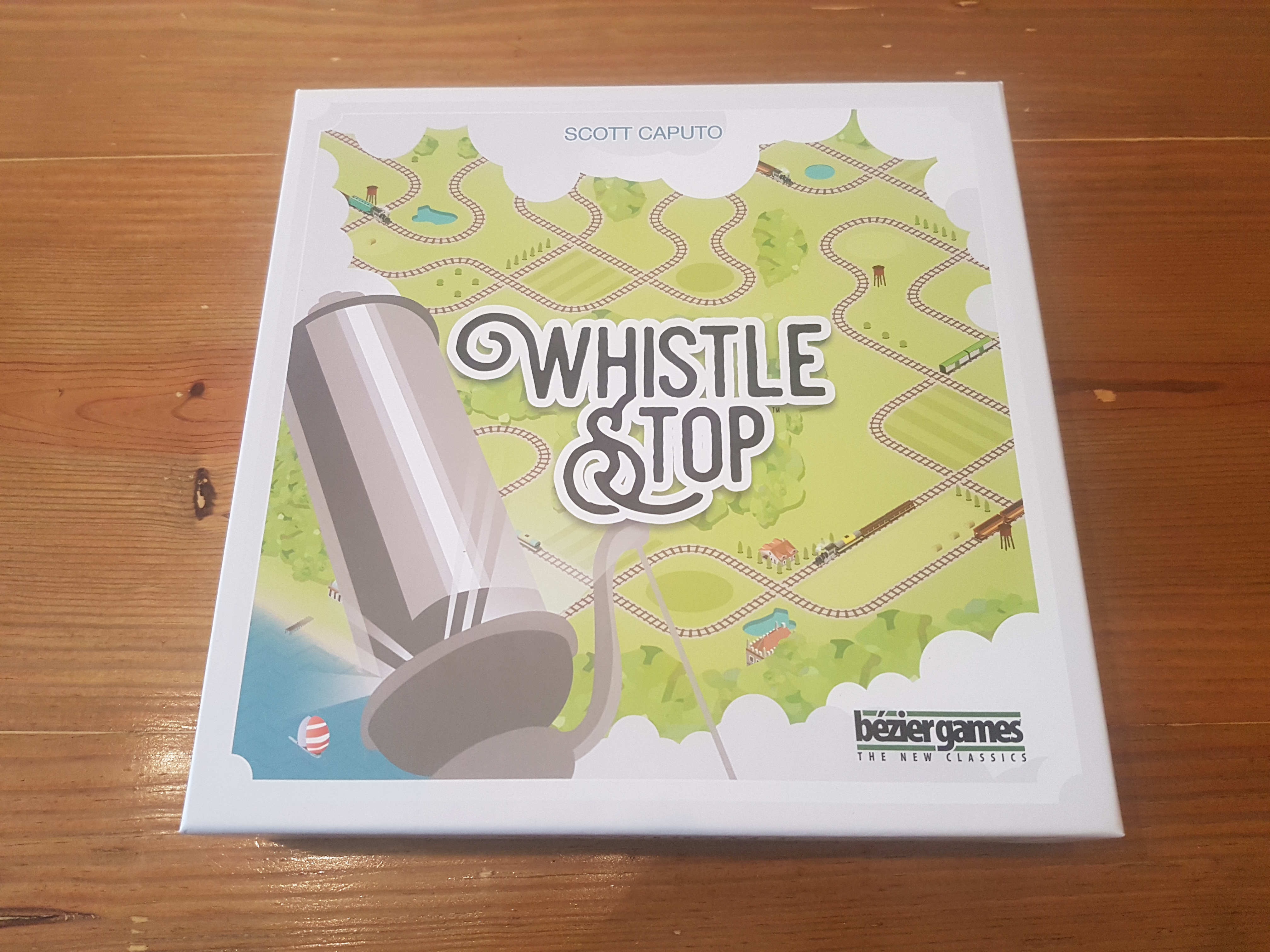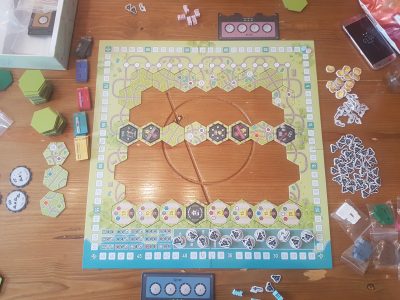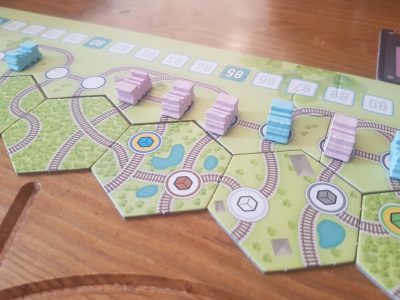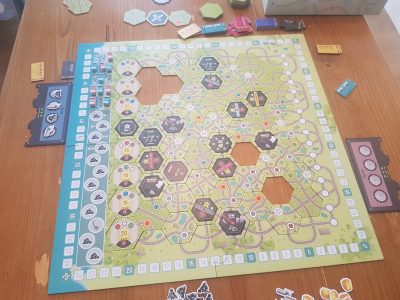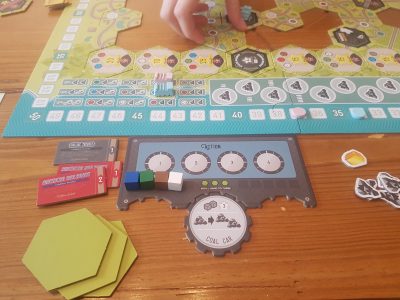Whistle Stop is a train game, so it isn’t an original theme. Saturation point is almost reached with the likes of Ticket to Ride for light games and Great Western Trail for those looking for a heavy train game. There is tile laying, resource collection, delivery mechanics and even a standard point tracker around the edge of the board. These are not new to board gaming. Yet, Whistle Stop manages to create an experience that feels very different, an accomplishment not to be looked over. It manages to balance these simple mechanics together into something which is far from the confusing mess I mistakenly anticipated.
Whistle Stop begins with little of the map actually in play. Instead, a stack of hexagons sits at the side of the board. “Board” being a loose term for something which has more gaps than board. Only three columns are initially set up. The left most column, which is effectively a finish line with special End tiles, a middle column full of special tiles and an Eastern starting column of standard track pieces. The finish line is made up of 8 randomly selected End titles that grant points if select resources are delivered. The tiles that make up the middle column include: 3 normal tiles, a coal stop, town stops, a trading post and a random other special tile.
After taking it in turns to select starting locations on the East of the map players will be spending up to 4 actions per round. At the start of a round players will be given 2 coal pieces each, unless it is a special whistle round. Coal allows a player to move a train to the next stop on a route, either westbound, northbound or southbound but never eastbound. A whistle is slight different as not only can you move in any direction you automatically skip over the first stop you arrive at. This can be extremely helpful when trying to gain combinations of resources. When a player gets to a resource stop their instantly gain that resource, unless they are already at the maximum of 10.
If you are travelling off the side of a tile, onto a gap, you can play one of the three hexagon tiles from your hand and the train continues until it hits a stop. This is how the board is filled in, and is necessary for the game to progress. Most tiles have stops on including regular or rare resource types, a few have no stops at all and then some are the special types. It is up to the players what to put down from their hand, considering what would benefit them the most. Remembering to not choose a tile which is best for you if it could be used more advantageously by an opponent. A coal stop is a great example as everyone stopping there would get coal not just you!
The special stops all do slightly different things. Town stops are a kind of mini End tiles as they work in a similar way. On Town Stops, as with the End tiles, players must trade in the indicated resource cubes to score. If a player manages to do this at a Town Stop they score the indicated points but also get the top stock token of matching colour. If they cannot a penalty of points is deducted from the player. At the conclusion of the game whomever has the most stocks of each colour gets a bonus of 15 points. This is a significant amount of points and in a 2-player game seems distorted scoring from getting to the finishing tiles.
Stores and trading posts will help players to gain coal or resources, needed to get to the End tiles and cash in for big points respectively. The Gold Mine is a slightly contentious one. When a player moves a train to a Gold Mine tile they take a random gold nugget. Ranging point wise from 3 – 5 points there isn’t enough variation to call the randomness even close to game breaking, so I’m happy with this slight luck mechanic being included. However, you could easily just remove it from the tile pile.
Whistle Stop has, in the last week, dropped down on Board Game Geek from a difficulty of 3.0 to 2.88 out of 5. This change represents a good adjustment. I’ve been able to introduce, and simply explain, the game to board gamers with only experience in the likes of Carcassonne and Catan. There is a lot going on: tile placement, resource delivery, upgrades to be brought and used, stocks to be purchased and then there are strategies to maximise points. Thankfully, each of these makes sense within the theming of the game and each action results in an obvious step forward.
One of the issue new players, that aren’t used to weightier games, come across is the possibility of having less available action points. This can make players stumble through a round or two if they haven’t planned ahead. It is somewhat a player’s choice to guarantee they have the maximum number of action points to be able to do 4 actions per turn though. Occasionally it is worth taking the hit on a future turn. Alas, it seems like punishment for the sake of it. If players instead automatically got 4 standard coal but had the potential to change coal to a whistle the same choice would be available without the limitations.
Like when playing Carcassonne, in Whistle Stop players will be placing tiles to create a map. Instead of roads and cities, players will be constructing a sprawl of twisting, interlinking railway tracks in an attempt to train from the East Coast. Just like in Carcassonne when gaps are left in what is otherwise a rather map-like artwork it pains me somewhat to my core. While it doesn’t pain me enough to throw a game to get those tiles filled in, there is certainly a satisfaction when the board is completely filled. Can I blame the game for this? Not at all, however I can be disappointed in my opponents if they don’t help me fill the board in!
For me the ideal player count for Whistle Stop is 3. The reasoning behind this is the game time and down time both severely ramp up as additional players join in on the railway laying action. As each player is added from 2 to 5 the game is reduced by a round and less trains are put into play for each player. Despite this because of the opportunity for over analysing moves, and the desperation for the optimised choices, the time between turns increases. At the full 5 players a single game took over two hours which for me was too long. At the other end of the spectrum, lasting closer to 45 minutes, a two-player game was much more welcoming and left me wanting more of that experience.
Many games with resource fall down when it comes to the components. Similar to Century Spice Road, the coloured cubes rather instantly lose their in-game meaning. The common resources of grey gravel, white cotton, brown lumber do an acceptable job. Conversely, the rarer cubes most would struggle to intuitively match them up. To the extent without consulting the rulebook countless times I still cannot remember which of green, blue and red equate to being whiskey, cattle or steel. Perhaps, the likes of Scythe, with unique shapes for the resources, has spoilt me but if you’re paying for a game you want the top quality.
I have pointed out a number of issues but these are easily forgotten when actually playing. After a few turns players will get what is going on and that is when the game truly gets going. If everyone can continue playing full steam ahead not only is the length is kept down but the enjoyment flows free. As soon as one player starts to overthink tile placement, or the route to take, there is a domino effect; where the other players then try to outdo the efficiency of others. The way the board expands throughout the game is a great twist, which alongside the movement gives amply player choice. While I cannot say Whistle Stop will often hit the table, due to me being very choosey whom plays to avoid the length rocketing up, I will enjoy playing when it does.
[Editor’s Note: Whistle Stop was provided to us by Esdevium Games for review purposes. The game is currently available on 365 Games for £52.99. It is also available from local UK board game stores, find your local store here]

